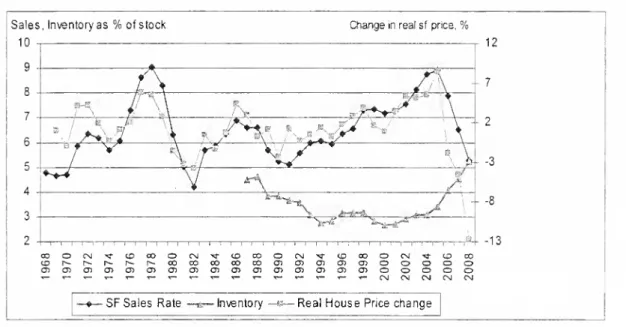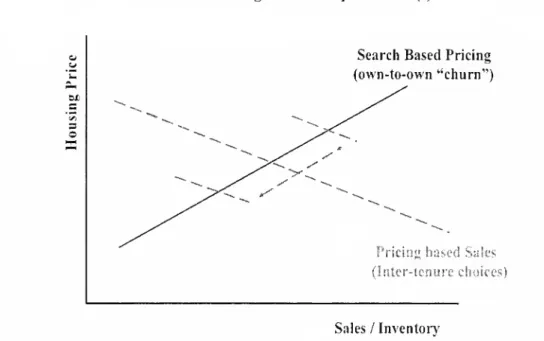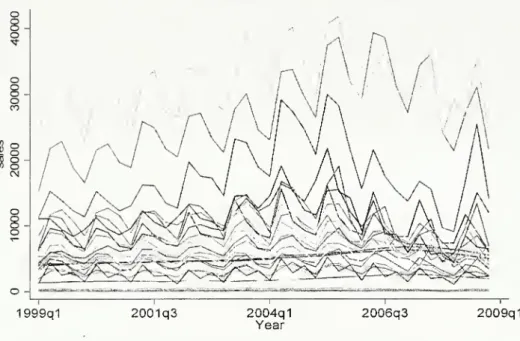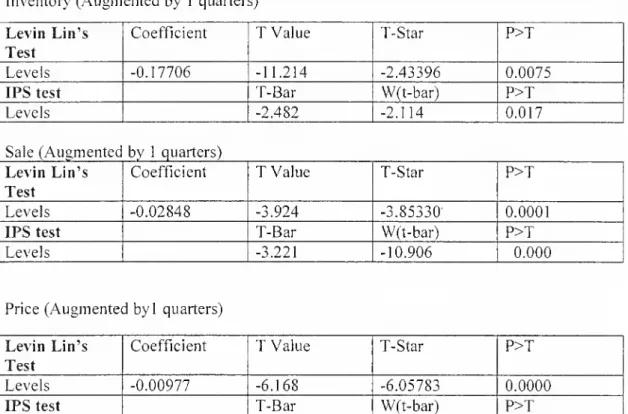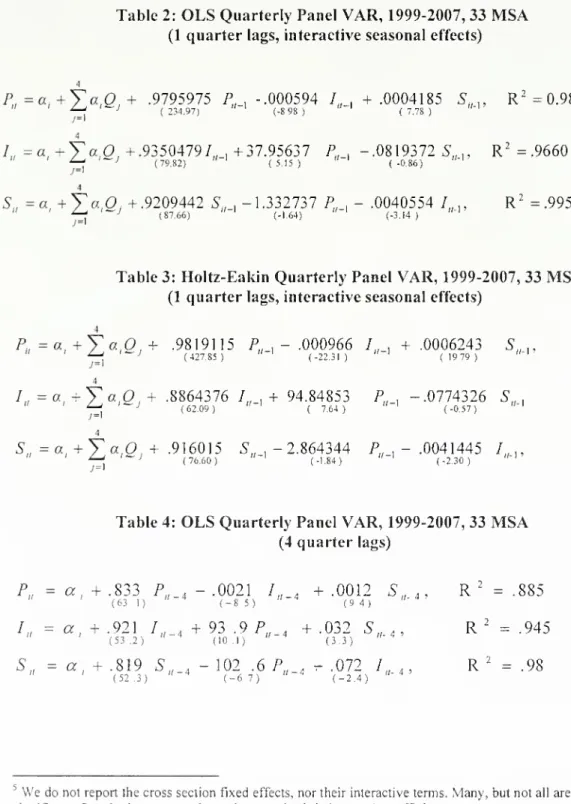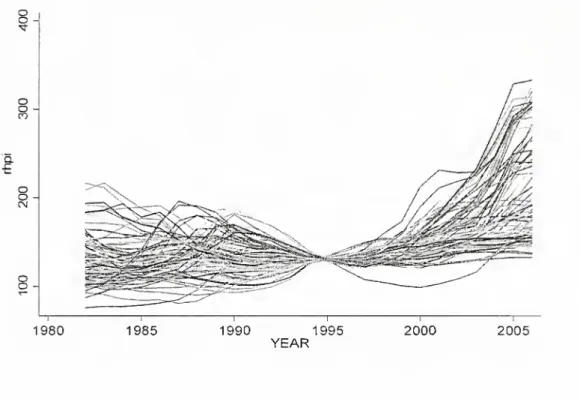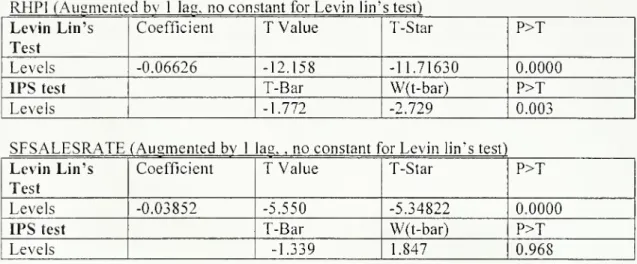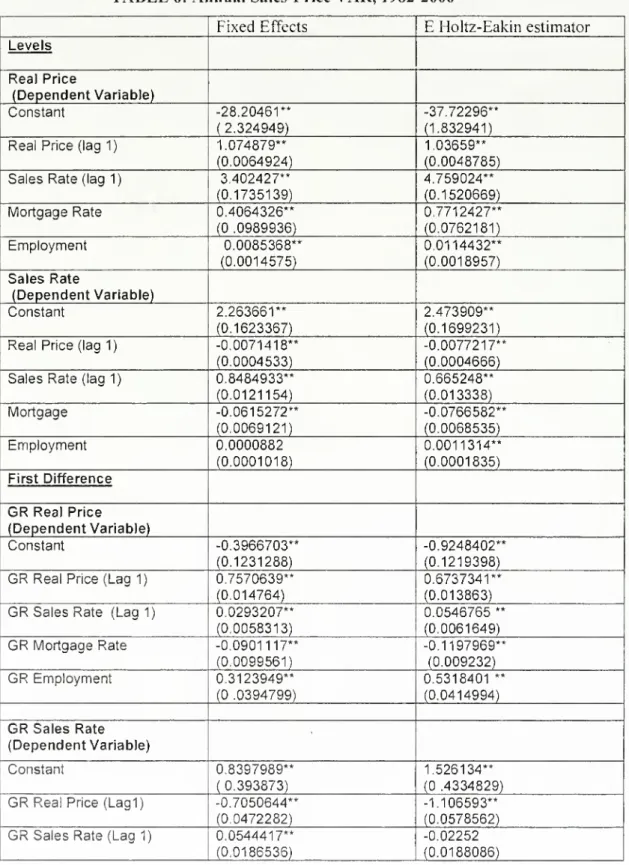iiiiiiiiiiiiiiiiiiiiiriilmHiifiiiiiiiiiiiiiiiiiiiii j
DEWEY
3
9080 02874 5138
no-
o^-
^
ZQo<\
Massachusetts
Institute
of
Technology
Department
of
Economics
Working
Paper
Series
The
Co-Movement
of
Housing
Sales
and
Housing
Prices:
Empirics
and
Theory
William
C.
Wheaton
Nai
JiaLee
Working
Paper
09-05
March
1,2009
REVISED:
May
24,2009
Room
E52-251
50
Memorial
Drive
Cambridge,
MA
02142
This
paper
can be
downloaded
withoutcharge from
the SocialScience
Research
Network
Paper
Collection at4th Draft:
May
24, 2009.The co-movement
of
Housing
Sales
and Housing
Prices:
Empirics
and
Theory
By
William C.
Wheaton
Department
ofEconomics
Center for RealEstate
MIT
Cambridge,
Mass
02139
wheaton@mit.edu
and
Nai Jia
Lee
Department
ofUrban
Studiesand Planning Center for Real EstateMIT
The
authors are indebted to,theMIT
Center for Real Estate,theNational Associationof Realtorsand toTortoWheaton
Research.They
remain responsibleforall results andconclusions derived there from.
ABSTRACT
This paper
examines
the strongpositive correlation that existsbetween
thevolume
of housingsales and housing prices.We
firstexamine
gross housing flows in theUS
and divide sales intotwo
categories: transactions that involve achange orchoice oftenure, asopposed
to owner-to-owner churn.The
literature suggeststhat the latter generatesa positive sales-to-price relationship, butwe
find that the formeractually representsthe majorityoftransactions.We
develop a simplemodel
ofthese inter-tenure flowswhich
suggests they generate a negativeprice-to-sales relationship. This runs contrarytoa differentliterature on liquidityconstraints and loss aversion. Empirically,
we
assembletwo
data basesto test themodel: a shortpanel of33MSA
covering 1999-2008 and a long panel of101MSA
spanning 1982-2006.Our
results from both arestrong and robust.Highersales "Granger cause" higher prices, but higherprices "Granger cause" both lower
salesand a
growing
inventory ofunits-for-sale.These
relationshipstogether provide amore
completepicture ofthe housing market-
suggestingthe strong positivecorrelationDigitized
by
the
Internet
Archive
in
2011
with
funding
from
Boston
Library
Consortium
Member
Libraries
I. Introduction.
As shown
in Figure 1 below, there is a strongpositive correlationbetween
housingsales (expressed as a percent ofall
owner
households)and themovement
inhousingprices
(R
=.66).On
the surfacethe relationship looksto be closetocontemporaneous. There isalso a
somewhat
less obviousnegative relationship betweenpricesandthe shorter serieson the inventory ofunits for sale
(R
=.51),A
number
of authorshaveoffered explanations forthese relationships, in particular thatbetween
pricesand sales.
Figure 1:
US
Housing
Sales,Prices, InventorySales, Inventoryas
%
ofstock 10Changeinreal stprice,
%
~+^-Z<
^**=N^
12 13ooorsj-^-cocoocMTrcoooocMTrtocoorM-^-cDco
tor^-r-r^r^r^cococococoa^oa^aicDooooo
T—^.—
T-T-T-T-r-.—
-^-.—T-T-T—
T-T-CMCMCMCMCN
SF
Sales Rate Inventory —a—
RealHousePricechangeOn
the one hand, there isagrowing
literature ofmodels
describinghome
owner
'"churn*" inthe presenceofsearch frictions
[Wheaton
(1990),Berkovec
andGoodman
(1996),
Lundberg
and Skedinger (1999)]. In these models, buyersbecome
sellers-thereare no entrantsorexits
from
the market. In such a situation ifparticipantspay higher prices, they alsoreceivemore
upon
sale. It is thetransaction costofowning
2homes
(duringthe
moving
period) that actually determines price levels.The
greater transaction costsaccompanying
high pricescanmake
trading expensiveenough
to erase the original gainsfrom moving. In this environment Nash-bargained pricesmove
almost inverselytosalesduration
-
equaltothe vacant inventory dividedby
the sales flow. Inthese models, both the inventoryand sales churn areexogenous. Following Pissarides (2000) ifthematching
rate isexogenous
or alternatively ofspecific form, greatersaleschurn will shorten duration and lead to higherprices. Similarly greatervacancy (inventory) raises sale duration and causes lower prices.There alsoare aseries of papers
which
proposethat negative changes in prices will subsequently generate lower salesvolumes. Thisagain is apositive relationshipbetween
thetwo
variables, butwith oppositecausality.The
first ofthese isby
Stein (1995) followedby
Lamont
and Stein (1999) and thenChan
(2001). In these models,liquidity constrained
owners
areagainmoving
from one house to another(''churn") andmust
make
adown
payment
in orderto purchasehousing.When
pricesdeclineconsumer
equity does likewise and fewerhouseholds havethe remaining
down
payment
necessaryto
make
a lateralmove.
As
pricesrise, equityrecovers and so does market liquidity.Relying instead on behavior economics,
Genesove
andMayer
(2001) andthen Englehardt (2003)show
empiricallythat sellerswho
would
loosesome
equityupon
sale sethigher reservationsthan thosewho
would
not.With
higherreservations, the market as awhole
should see lowersales if
more
andmore
sellersexperience loss aversion aspricescontinue todrop.
Inthis paper
we
tryto unravel the relationshipbetween
housingprices andhousing sales, and in addition, the inventory of housingunits for sale.
We
accomplish the following:1). First,
we
carefullyexamine
gross housing flows in theAHS
forthe 1 1 years inwhich
thesurvey is conducted and findthere aremore
purchases ofhomes
by rentersornew
households than thereare by existing owners.Hence
the focusonown-to-own
trades doesnot characterizethe majorityofhousing sales transactions.2).
We
alsoexamine which
flows add tothe inventory offor-sale units (calledLISTS)
andwhich
subtract (calledSALES).
'Own-to-own moves,
forexample do
both.We
show
with a simplemodel
oftenure choice flowsthathigherpricesshould generatemore
LISTS,
lowerSALES,
and hence a larger inventory.When
prices are low, the reversehappens.3). This leads us to hypothesize a veryspecific form ofjoint causality
between
salesand prices.
Own-to-own
churngenerates a positive schedulebetween sales andprices as suggested by frictional markettheory. At the
same
time, inter-tenure transitions should lead toa negative schedule. In equilibrium, the overall housing market should restatthe intersection ofthese
two
schedules.4).
To
testthese ideaswe
firstassemble aUS
panel data baseof33MSA
from 1999-2008.The
shortnessofthepanel is due to limited data on the for-saleinventory.An
estimated panelVAR
model
perfectly confirms ourhypothesized relationships. Sales positively drive subsequent priceswhile pricesnegatively drive subsequent sales andalso positively increasethe inventory.5).
We
also assemblea longer panel of101MSA
from 1982 to2006
onjust salesand prices.
Using
awide
range ofmodel
specificationsandtests ofrobustnesswe
find again thatsalespositively"Granger cause" subsequent housing pricemovements,
whileprices negatively"'Grangercause" subsequent housingsales.
These
jointrelationshipsare exactlyas ourmodel
suggestswhen
owner
churn iscombined
with inter-tenuremoves.
Our
paper is organized as follows.In section IIwe
setup an accountingframework
formore
completely describing gross housing flows fromthe 2001AHS.
This involves
some
careful assumptionsto adequatelydocument
the magnitude ofall theintertenure flows relative towithin tenure churn and to householdcreation/dissolution. In
Section III,
we
develop asimple stylizedmodel
ofthe inter tenureflowsto illustratehow
theycan generate a negativerelationship
between
pricesand salesand a positive relationshipbetween
prices and inventory.We
present ourhypothesized pair ofrelationships
between
pricesand thesales/inventory ratio. In sectionIV
we
testthese ideas with a shortpanel data base (33MSA)
that coversthe inventoryaswell as pricesand sales. In sections
V
through VIIwe
present an analysis ofa longer panel datasetbetween
just salesandprices across 101MSA
coveringthe yearsfrom 1982-2006.Here
again
we
find conclusive evidencethat salespositively"Granger cause" prices and that prices negatively"Granger cause" sales.Our
analysis is robusttomany
alternative specificationsand subsample tests.We
conclude withsome
thoughts about historicII.
US
Gross
Housing
Flows: Sales, Lists,and
the Inventor}'.Much
ofthe theoretical literature on sales and prices investigateshow
existinghomeowners
behaveastheytry and sell theircurrenthome
to purchaseanew
one. This flow ismost
often referred to as "churn".To
investigatehow
important arole "churn" plays in the ownershipmarket,we
closelyexamine
the 2001American Housing
Survey.In "Table 10"ofthe Survey, respondentsare asked aboutthe tenureofthe residencethey previously lived in
-
forthosethatmoved
during the lastyear.The
totalnumber
ofmoves
in this question isthesame
asthetotal in "Table 11"-
asking aboutthepreviousstatusofthecurrent head (therespondent). In "Table 1
1"
itturns out that
25%
ofcurrentrenters
moved
from a residence situation inwhich
theywere
not the head (leavinghome,
divorce, etc.).
The
fraction is a smaller12%
forowners.What
is missing is thejoint distributionbetween
moving
by the head andbecoming
a head.The
AHS
is notstrictlyable to identify
how many
currentowners
moved
eithera)from
anotherunit theyowned
b)anotherunitthey rented orc) purchaseda house asthey
became
anew
ordifferenthousehold.
To
generate the full setofflows,we
use information in"Table 11" aboutwhether
the previous
home
was
headed bythe currenthead, a relative oracquaintance.We
assume
that all currentowner-movers
who
were
alsonewly
created households -were
counted in "Table 10" as beingpartofapreviousowner
household. For renters,we
assume
that all renter-moversthatwere
alsonewly
created householdswere
counted in"Table 10"inproportionto renter-ownerhouseholds inthe full sample. Finally,
we
use theCensus
figures thatyear forthe netincrease in each type of household, andfrom
that togetherwith the dataonmoves
we
are able to identify household "exits" bytenure.Gross household exitsoccur mainly through deaths, institutionalization(such as to a nursing home), or marriage.
Focusingonjustthe
owned
housingmarket,theAHS
alsoallows usto accountfor virtually all oftheevents thatadd units to the inventoryof houses for sale (herein called
LISTS)
and all ofthose transactionsthatremove
units fromthe inventory (herein calledSALES).
Therearetwo
exceptions.The
first isthe netdelivery ofnew
housingmarket. Since
we
have nodirect count ofdemolitions'we
use thatfigure also as netand
it is counted asadditional
LISTS.
The
second isthe net purchases of2ndhomes,which
must
be counted as additionalSALES,
butaboutwhich
there is simply little data". In theory.LISTS
-
SALES
should equalthechange in the inventoryofunits forsale.These
relationships are depicted in Figure 2and can be
summarized
with the identitiesbelow
(2001
AHS
values are included).SALES
=
Own-to-Own
+ Rent-to-Own
+
New
Owner
[+ 2 ndhomes]
=
5.281.000LISTS
=
Own-to-Own +
Own-to-Rent
+ Owner
Exits+
New
homes =
5,179.000 InventoryChange
=
LISTS -
SALES
Net
Owner
Change =
New
Owners
-
Owner
Exits+
Rent-to-Own
-
Own-to-Rent
Net
RenterChange =
New
Renters-
Renter Exits+
Own-to-Rent
-
Rent-to-Own
(1)
The
only othercomparabledata is from theNational Association ofRealtors(NAR).
and itreports that in2001 the inventory ofunits for salewas
nearly stable.The
NAR
however
reportsaslightly higher level ofsales at 5.335.000 existing units. This small discrepancy could beexplained by repeatmoves
withinasame
year since theAHS
asksonlyaboutthemost
recentmove.
Itcould also represent 2ndhome
saleswhich
again are not partoftheAHS
move
data.What
ismost
interesting to us is that almost60%
ofSALES
involve a buyerwho
is nottransferringownership laterally from one
owned
houseto another.So
called"churn"is actually a minorityofsalestransactions.
The
variousflowsbetween
tenure categoriesalso arethemore
critical determinant ofchange-in-inventory since"churn"salesleave the inventory unaffected. .
Thegrowth in stockbetween 1980-1990-2000 Censusescloselymatchessummedcompletionssuggesting
negligibledemolitionsoverthosedecades. The samecalculation between 1960 and 1970howeversuggests
removal of3 millionunits.
2
Netsecondhomepurchasesmight beestimatedfromtheproductof: theshareoftotal grosshome
purchasesthat aresecondhomes(reported by LoanPerformanceas 15.0%) andtheshare ofnew homes in total homepurchases(Census,25%). Thiswouldyield 3-4%oftotaltransactionsorabout200,000units.
Therearenodirectcountsoftheannualchange in2" homestocks.
The
AHS
isarepeatsample of housingunitsand excludesmovesintonewhouses.Thuswecompare itsFigure2:
US
Housing
Gross Flows
(2001)>nd
Net
2Home
Purchases(SALES)
(1)New
Owner
households=
564,000(SALES)
RentertoOwner
=
2,468.000(SALES)
(1)New
Renter households=
2.445,000Owner
toOwner
=
2,249.000(LISTS
&
SALES)
Owners =
72,593,000Net
Increase=
1,343,000 Renters=
34,417,000Net
Increase=
-53,000 Renterto Renter=
6,497.000 (2)Owner
Exits=
359,000(LISTS)
Owner
to Renter=
,330,000(LISTS)
Net
New
Homes
=
1.242,000.(LISTS)
(2) RenterExits
=
1,360,000In Figure 2.
most
inter-tenureSALES
would
seem
to be eventsthatone might expectto be negatively sensitive tohousing prices.When
prices are high presumablynew
created
owner
household formation is discouraged orat leastdeflected intonew
renterhousehold formation. Likewise
moves
which
involvechanges intenure from renting toowning
also should be negatively sensitive tohouse prices.Both
result becausehigher pricessimplymake
owning
a house lessaffordable.At
thistimewe
are agnostic abouthow
net 2ndhome
salesare related to prices.On
theotherside ofFigure 2,many
ofthe events generatingLISTS
should be atleast
somewhat
positively sensitive to price.New
deliveries certainlytryto occurwhen
to "cash out",
consume
equity orvoluntarilychoose to switchto renting. Atthis timewe
are still seeking a direct data source
which
investigates inmore
detailwhat
events tend to generate the own-to-rentmoves.Thus
theflows inand outofhomeownership
inFigure 2 suggestthatwhen
prices are high sales are likely to decrease lists increaseandtheinventory grow.
The
AHS
hasbeen conducted only semi-annually until recently and alsohas used consistentdefinitions ofmoving
only since 1985. InAppendix
IIIwe
calculate the flowsforeachofthe 11
AHS
surveys between 1985 and 2007.The
flows are remarkablystable, although there exists
some
yearto yearvariations. In all years,own-to-own
moves
("chuirT) are less thanthe
sum
ofnew
owners
plus rent-to-ownmoves. Sincethe2001 survey, theAHS
calculated values forLIST-SALES
have increased significantly. This isconsistent withthe
growing
national for-sale inventory reported in theNAR
dataoverthis period.
III.
A
stylizedmodel
of inter-tenureflows.Here
we
assume
that thetotalnumber
of householdsT
is fixed withH
<
T
beinghome
owners.Those
notowning
rent atsome
fixed (exogenous) rent-
hencewe
largely ignore the rental market.The
total stockofunitsavailable for ownership U(p) isassumed
to
depend
positively on price (longrun supply) and with fixed rentswe
ignore rental supply. In this situation the inventoryofunits for sale is the difference between theowner
stockandowner
households: I=
U(p)-
H.Households
flow outof ownershipatsome
constant rateawhich
could representunemployment,
foreclosure,or othereconomic
shock. Rental households purchase units out oftheowner
stock(become
owners)atsome
rate s(p)which
we
presume
depends negativelyon price.High
prices (relative to the fixed rent)make
ownership lessappealing, but in general renterswishto
become
owners
becauseofsome
assumed
advantage(atax subsidy forexample).
-
hencethe purchaserate isalways positive.The
equationsbelow
summarize
both flows (timederivatives) andsteady statevalues (denoted with *). In Equation (2) the stable
homeownership
ratedependsnegativelyon prices and the constant
economic
shock rate.When
pricesgenerate a sales rate equal to theeconomic
shockrate,homeownership
is50%.
Equation (3) cleanlydivides up the inventory
change
intothesame
two
categoriesfrom
ourmore
detailedflow diagram:LISTS-SALES.
Here
LISTS
are stockchange(new
construction) plusown-to-rent flows
(economic
shocks) whileSALES
are rent-to-own flows.The
equilibrium levelof
SALES
is in (5),and the equilibrium inventory in (4).The
lattermust
beconstrained positive.dH/dt
=
s(p)[T-H]-aH,
H'
=
S("P)T
(2)a
+
s(p) dlIdt=
dU
Idt-
dH
Idt= [dU
Idt+
aH]-
s(p)[T- H],
(3 )l'=U(p)-H'
=
<*U(P)+ s(P)U(P)-sT>o
(4)a
+
s{p).
as(p)T
s(p)[T-H
]=
—
(5)a
+
s{p)In (6)
we
derive comparative staticswhich
show
thatas prices increase,the steadystate valueofthe inventory
grows
and thesteady state level ofSALES
decreases-
ashypothesized aboutthe flows
which
were diagramed
in Figure 2.dl' I
dp
= dU/dp-dH'
/dp=
dU/dp-
P
[\—
^7
>0
(6)a
+
s a+
sd
(s(P
)[T-H'])/dp=
£™^[l-^_]
<
a
+
sa
+
sAgain,the conclusions
above
follow from theassumptionsthat long run stock is positively related toprice and the salesrate is negative relatedto price.Thus
thissimplemodel
ofinter-tenure flows establishes a negative relationshipbetween
housingpricesand Sales/Inventoryratios. Alternatively, there should bea positive relationship
between
pricesand duration.
With
thisnew
schedulebetween
pricesand durationwe
arenow
readytobetter describethe full setofrelationships in theowner
marketbetween
sales, pricesand the inventor)'.We
combine
thisnew
schedule with a positive schedulebetween
prices and the Sale/Inventory ratio-
created fromthe variousmodels
ofown-to-own
decisions. Inthese latter
models
itis sales that are determining prices, while with themodel
in (2)-(5)above
it is prices that aredeterminingsales.At
amore
complete equilibrium (in theownership market) sales, pricesand the inventory all rest atthe intersection ofthe
two
schedules
shown
in Figure3. Figure 3 presents amore
completepicture ofthe housing market thanthemodels
ofStein,Wheaton,
orBerkovec
andGoodman
-
since itaccountsforthevery large role ofinter-tenure mobility aswell as for
owner
churn.FIGURE
3:Housing
Market
Equilibrium(s)Search BasedPricing (own-to-own "churn")
WO
Pricingbased Sales (Inter-tenure choices)
Sales/Inventory
The
out-of-equilibriumdynamics
ofthismodel
are alsoappealing andseem
inlinewith
economic
intuitionas well. Considera permanentincrease ineconomic
shocks(a).
Using
(2)- (5),owner
householdsdecline, andthe inventory increases. Saleshowever
also increaseand sothe impact on duration is technically ambiguous. Within a
wide
range ofreasonable parametervalues however,
we
canshow
that the sale/inventoryratiodeclineswith greatera
-
the netshift in the price-to-sales schedule is therefore inward.The
new
equilibrium then results in lowerprices with a lowersales/inventory ratio as well (a higherduration). Ifwe
shiftthe s(p) scheduleup (e.g. a greater tax subsidy)thenumber
ofowners
increases, the inventory drops, and sales increase. This leadsto an4
unambiguous
rightward shift in the price-to-salesschedule with a corresponding rise inequilibrium Sales/Inventory (drop in duration). Pricesof course rise as well.
The
next task isto see ifwe
canempirically identifythe relationships in Figure 3.Forthis,
we
examine
two
several panel databases with different degreesofrichness.The
first data base isshorterand covers only 33
MSA.
Its advantage isthat it includes dataon
the inventory for sale by market
-
a serieswhich
theNAR
has collected only recently.The
second database ismuch
longer, covers 101MSA,
but includes only informationon
sales and prices.
IV.
A
Short Panel
Analysis ofMetropolitan
Sales, Pricesand
Inventory.Carefully constructed series on house prices areavailable from the late 1970sor early 1980s and fora
wide
rangeofmetropolitan areas.The
pricedatawe
use isthe deflatedOFHEO
repeat sales series [Baily,Muth,
Nourse
(1963)].This data series has recently been questioned fornot factoring outhome
improvements
ormaintenance andfornot factoring in depreciation and obsolescence [Case,Pollakowski,
Wachter
(1991), Harding. Rosenthal, Sirmans (2007)]. Thatsaidwe
are leftwithwhat
isavailable, andthe
OFHEO
index is themost
consistent series available formost
US
markets overa longtimeperiod.
The
only alternative isCSW/FISERV,
and it is available forfar fewer metropolitan areas that in turn aredisproportionately concentrated in the south and west.In termsofsales,the only consistent source isthatprovided
by
theNational Association ofRealtors(NAR).
The
NAR
data is forsingle family unitsonly (it excludescondominium
sales attheMSA
level), butis availableforeachMSA
over a periodfrom
1980to the present.
The
more
limitingdata series is thaton the inventory of housingunits forsale.
Here
theNAR
distributesMSA
data only from 1999 orlater.We
have beenable toputtogetherall three series since 1999 for33
MSA,
and Figures4 through 6 depictthe 33 series foreach variable.The
patterns arequitediscernable and inAppendix
I
we
presentsummary
statisticsforeach market.In Figure 4
we
clearly see all house prices risingand thenfalling since 1999.The
sample almost evenly divides
between
marketwhere
thismovement
is verypronounced
and those with onlythe slightestofchanges. Interms ofthe inventory, Figure 5shows
thatover the firsthalfofthe samplethe inventory
was
roughly constant. After2004
itrises and falls in a pattern again similarto prices. Boththe Pricesand Inventoryare
raw
series andexhibit little seasonality.
As
forsales, in Figure 6we
see a littlebit ofthesame
"hump
shaped"pattern, but itseems
weaker.What
ismore
problematic with the sales data is thestrong pattern ofseasonality in each series-
seasonalitythatvaries by specificmarket in
many
cases.Figure4:
Quarterly Real
House
Prices (33MSA),
1999-2008
o
inn
o
o
o
OJ D.E
o
o
O
o
o
-1999q12001q3
2004q1 Year 2006q3 2009q1Figure5:
Quarterly
For-SaleInventory (33MSA),
1999-2008
o
o
o
o
o
m
o
o
o
o
o
\ro
o
o
o
o
Q) COo
o
o
o
o
o
o
o
1999q1 2001q3 2004q1 Year 2006q3 2009q1 13Figure
6:Quarterly
House
Sales (33MSA),
1999-2008
o
9c
c
c
o
n
8g
o
o
CM1
o
8
o
1999q1 2001q3 2004q1 Year 2006q3 2009q1These
observations suggestthata panelVAR
is an appropriate instrumenttotestthe relationships
between
prices, sales and inventory. In theVAR
we
will have each variable depending on lagged values ofitselfand theothervariables. Ifthe panel is of order one,we
also can use each coefficient asaneffectivetestof"Granger
causality".Before turningto such amodel, however,
we
needtoexamine
each seriesto see ifthey are stationary. Therearetwo
tests available foruse with panel data and in each, the null hypothesis is thatsum
oraverageofallthe individual series have unit rootsand arenon
stationary. In Levin-Lin (LL, 1993) the null hasno constant(ordrift)while in
Im-Persaran-Shin (IPS, 2002) the null includes a constantto allow fordrift. In Table 1
we
reportthe resultsofthis testfor housingprices, sales and inventory
-
in levels.With
the possible exception ofprices,where
we
can be confident only atthe7%
level, the non-stationary null is rejected andwe
should be on solid grounds undertaking our proposedVAR.
Table
1: Stationary tests,Short PanelInventory'
(Augmented
by 1 quarters)Levin
Lin'sTest
Coefficient
T
Value T-StarP>T
Levels -0.17706 -11.214 -2.43396 0.0075
IPS
testT-Bar
W(t-bar)P>T
Levels -2.482 -2.114 0.017
Sale
(Augmentec
by 1 quarters)Levin
Lin'sTest
Coefficient
T
Value T-StarP>T
Levels -0.02848 -3.924 -3.85330 0.0001
IPS
testT-Bar
W(t-bar)P>T
Levels -3.221 -10.906 0.000
Price
(Augmented
byl quarters)Levin
Lin's TestCoefficient
T
Value T-StarP>T
Levels -0.00977 -6.168 -6.05783 0.0000
IPS
testT-Bar
W(t-bar)P>T
Levels -1.750 -1.477 0.070
In panel
VAR
models
with individual heterogeneitythere exists a specification issue: the errorterm can becorrelatedwith the lagged dependent variables [Nickell, (1981)].OLS
estimation can yield coefficients that areboth biased and also that arenot consistent in thenumber
ofcross-section observations. Consistency occursonly in thenumber
of time series observations.Thus
estimatesand anytests on theparameters ofinterest
may
notbereliable.These
problems might notbe serious inourcase sincewe
have 32 quarterlytime series observations(morethanmany
panel models).To
be on thesafe side, however,
we
also estimated the equations following an estimation strategy byHoltz-Eakin et al.
As
discussed inAppendix
II, thisamounts
to using 2-period lagged values ofsales andprices as instruments withGLS
estimation.A
final concern with ourVAR
isthe handlingofseasonality.Here
we
propose 2adjustments. In Tables 2and 3,
we
report results using quarterly seasonal effectsinteracted withthecross section fixed effects. This effectivelyallows each
MSA
to have itsown
setofseasonal influences.Our
second approach isto change all ofthe lags intheVAR
to4-periods ratherthan one. In effectwe
areaskinghow
ourvector ofvariablesrelates to thevector lagged a year previousratherthan a quarter ago.
The
year-over-yearVAR
results are presented in Table 4.5
Table
2:OLS
Quarterly Panel
VAR,
1999-2007,33
MSA
(1
quarter
lags, interactive seasonal effects)P=a
+YaO,+
.9795975P
u . -.000594 /„ ,+.0004185
S,n
,R
2=0.9889
" '4f
'*-> (234.97) ""' (-8,98) ""' (7,78) ""' 4 /=
a,+Y
a,O,+.93504797,
.+37.95637
P..-.0819372
5,,.,R
2=.9660
" '^
'-' (79.82) ""' (5.15) ""' (-0.86) ""'' 4S
=a+Ya,0,
+.9209442
S
u .-1.332737
P. ,-
.0040554 /„..R
2=.9950
(87.66) (-164) (-3.14)Table
3:Holtz-Eakin Quarterly Panel
VAR,
1999-2007, 33MSA
(1
quarter
lags, interactive seasonal effects)p
'=
a
,+
Y
a,0,+
.9819115 P...-
.000966 I...+.0006243
S.n
, " 'j^
'~> (427.85) ""' (-22.31) ""' (1979) ""' 4 /=
a
.+
Y
a,Q,
+
.8864376 /„ ,+
94.84853 P„ ,-
.0774326 S„ , " '^
' («09) """' ( 764) "-' (-0.57) ""' 4 S.=
a,.+Ya,.0,T
.916015 5„,-
2.864344
P,.-
.0041445 /, ,, '^
J (76.60) "-l (-184) ""' (-2.30) ""'Table
4:OLS
Quarterly
PanelVAR,
1999-2007,33
MSA
(4
quarter
lags)P„
=
a,
+
.833P„
4-
.0021 /„ 4+
.0012
5,
4,R
-=
.885 (63 1) "-4 (-S 5) ""4 (9 4) "" 4 ' /„= a, +
.921 /„_<+93
.9/>„_4+
-032 5„.4>R
2=
.945 (53 .2) (10.1) (3 3)S„
= a,
+.819
S„_
4-102
.6P„_
4-.072
7„.4 ,R
2=
.98 (52 .3) (-67) (-2.4) 5We
donot report the cross section fixed effects,northeirinteractiveterms. Many, butnotallaresignificant.Standarderrorsareshownin parenthesisbeloweach coefficient.
In
examining
Tables2-4,we
find that ourthree hypotheses are validated in every case. First,the inventory negatively impactsprice while sales hasa positive effect.Interestingly thecoefficienton inventory is alwaysslightly largerthansales. Ina log
model
ifthe ratio(duration)were
all thatmattered the coefficientswould
be identical inmagnitude. In this linear
model
theyare closeenough
to suggesta similarconclusion. Secondly, the inventory respondsquite significantly (and positively) to prices. Thirdly, prices negatively impact subsequent sales. All ofthese effects are statistically significant, but the price impact on Salesshows up
more
strongly inthe 4-quarter lagmodel. In the1-quarter
model
itis atthe thresholdofsignificance. In all respects, the results fully support equations (2)-(5) and the pairofrelationships in Figure 3. Duration negatively"Granger
causes" subsequentprices to decline. Pricethen positively
"Granger
causes" theinventoryto grow, and likewise for sales to decline.
The
firstVAR
equation validates theupward
schedule in Figure3 whilethe secondand thirdcombine
to yield thedownward
schedule.
In
comparing
the differentmodels
we
note that the Holtz-Eakin estimation does increasethe coefficients abitand reduce standard errors-
relative to theOLS
results.We
did notundertake Holtz-Eakin estimation for our 4-quarter lag model.
The
OLS
4-quarter results areexpected!}' different. Inventoryand sales, forexample, have an impactonprices4 periods hencethat is roughly4 timestheir impact inthe 1-quarter model.
Similarly, prices impactsales 4 quarters hencewith
much
greater impactthan fromjust 1quarterback.
V.
A
long-PanelofMetropolitan Salesand
Prices.It is possible totestthe just the relationshipbetween prices and salesovera
much
longertime horizon-
ifwe
ignore theinventory.6 Forthiswe
assemblea larger panel data base covering 101MSA
and spanning theyears 1982 through 2006. This panelwas
6
There have beenafewrecentattemptstestthe relationshipbetweenmovementsinsales andprices. Leung, Lau, andLeong(2002) undertakeatimeseriesanalysisofHong KongHousing and concludethat
strongerGrangerCausalityisfoundforsalesdrivingprices ratherthan pricesdrivingsales. Andrewand
Meen(2003)examinea
UK
MacrotimeseriesusingaVAR
model andconcludethattransactions respond toshocksmorequickly thanprices,butdonot necessarily "GrangerCause"priceresponses. Bothstudiesarehamperedby limited observations.
purposely structured to be annual so asto avoid the seasonalityofthe shorter panel,while still maintaining plentiful time-based degrees of freedom.
Over
this longer period,many
metropolitan areas almostdoubled theirhousing stock sowe
decided to standardizethe salesdata to eliminatesome
ofthe trend.Raw
saleswere
compared
with yearlyCensus
estimates ofthenumber
oftotal households inthose markets. Dividing singlefamily sales
by
total householdswe
getan estimated sales rate for each market in each period.Using
sales rates also eliminatedmuch
ofthecross section variation intheraw
number
ofsales. In a similarmanner
we
setthereal price level in each marketto 100 in the baseyear.These
re-scalingofthe datawill helpmake
thecross section fixed effects smaller in the estimated
VAR
models.In Figures 7and 8
we
illustratethe constant dollarOFHEO
price seriesalong with the yearlyNAR
sales rate data, forall 101 of ourmarkets.Over
this time frame, the priceseries vary widelyacross markets, withsome
areas experiencing long termalthough episodic increases (e.g. San Francisco)while othersare almosttotally constant
(e.g. Dallas).
As
forthe salesrates, virtually everymarkethas aslow gradual trend insalesrates, with the
sample
average increasing from3%
to 5.6%.
InappendixIIIwe
presentthe
summary
statistics for each market'sprice and sales rate series.The
data in Figure 4through 6 forthe shortpanelshowed
no obvioustrends;'prices, sales and the inventory generallyriseand then fall.
The
longerterm series inFigures 7 and 8
may
havemore
persistenttrends and so againwe
need to test forwhether
theseries are stationary. InTable 5
we
reporttheresults ofboth Levin-Lin and IPStests forboth housing priceand sale rate levels.With
bothtests the null for house prices is rejected athighconfidence levels, butwiththe IPS testthe null hypothesis forthe sales rate is quite likely to hold.
Given
the steady trends seen in Figure 8, this of courseseems
reasonable.To
be onthe safe side,then
we
estimateour long term sales-priceVAR
in differences aswell as levels.Figure7:
Annual House
Prices (101MSA),
1982-2006
o
o
CO a.o
o
1980 1985 1990 1995YEAR
2000
2005
Figure8:
Annual
SalesRate
(101MSA),
1982-2006
CD a CO Lf) 1980 1985 1990 1995
YEAR
2000
2005
l"TABLE
5: Stationary tests,Long
Panel
RHPI
(Augmented bv
1 lag, no constant forLevin lin's test)Levin
Lin's TestCoefficient
T
Value
T-StarP>T
Levels -0.06626 -12.158 -11.71630 0.0000IPS
testT-Bar
W(t-bar)P>T
Levels -1.772 -2.729 0.003
SFSALESRATE
(Augmented
bv
1 ag. .no
constantfor Levin lin's test)Levin
Lin's TestCoefficient
T
Value
T-StarP>T
Levels -0.03852 -5.550 -5.34822 0.0000
IPS
testT-Bar
W(t-bar)P>T
Levels -1.339 1.847 0.968
Since
economies change
more
in the longer term,we
decided to include several conditioning variables.The
conditioning variableswe
choose are market specificemployment,
and thenationalmortgage
rate.The
resulting 2-variableVAR
in levels isshown
in(7), while in(8) thecompanion model
ispresented in first differences.P,j
=ao+«i p
/.,-i
+«aV,
+
/7'^//+
3
+*,.,Su
=7o
+
r,Vi
+/2
P
U-\+^
X
U +
7l+£
u
AP,,=a +a
iAP
IJ_l+a
2AS
IJ_l+/3'AX
IJ+5,
+£,, ^,.«=7o +
/iA
V>
+y
2&P,.l_i+A
,AX,
J +?],+£
(7) (8)We
estimateeachmodel
using bothOLS
andalso applying the previously discussed estimation strategyby
Holtz-Eakin etal.From
either estimates,we
conduct a"Granger"
causalitytest. Sincewe
are onlytesting for a single restriction, the t statistic is the square root oftheF
statistic thatwould
be used to testthehypothesis in the presence ofa longer lag structure (Greene,2003). Hence,we
can simply use a ttest (appliedto7
In (6)the fixedeffects arecross-section trendsratherthan cross sectionlevels asin(5)
thea, and
y
2)as thecheck ofwhether changes in sales"Granger cause" changes in price and/orwhetherprices"Granger
cause" sales.In table 6
we
report the results ofequations(7) and(8) in each setofrows.The
firstcolumn
usesOLS
estimation, thesecond theRandom
EffectsIV
estimatesfrom
Holtz-Eakinet al. Interestingly, the
two
estimation techniquesyield quite similar coefficients-
asmight be expected with a largernumber
oftimeseries observationsand datarescaling to reduce the cross sectioneffects.The first setofequations is in levels,while the second setof
rows
reportsthe resultsusing differences. In all Tables, variablenames
are selfevidentand variable differences are indicatedwith the prefixGR.
Standarderrors are reported in parenthesis.
Among
the levels equations,we
firstnoticesome
anomalies.The
mortgageinterest rate inthe price levels equation is always ofthe
wrong
sign, andtheemployment
coefficient inthe
OLS
sales rate equation is insignificant (despitealmost2500
observations).
A
more
troublesomeresult isthat the price levelsequation has excess"momentum"
-
lagged priceshave acoefficientgreaterthan one.Hence
prices (levels)can
grow
on theirown
without necessitating any increases in fundamentals, orsales.We
suspectthatthese
two
anomaliesare likely the resultofthe non-stationary feature toboth the price andsales serieswhen
measured
in levels.When we move
tothe results of estimating theequations in differences all ofthese issues disappear.The
lagged price coefficients are lessthan one so the price equations are stable in the 2n degree, and the signsofall coefficients are both correct-
and highly significant.As
tothe question ofcausality, in everyprice orprice growth equation, lagged sales orgrowth in sales is always significantly positive.Furthermore in every salesrate or growth in sales rateequation, lagged prices (or itsgrowth) arealso alwayssignificant.There is clearevidence ofjoint causality,
and
the effectof
laggedpriceson
salesisalways
of a
negativesign. Holding lagged sales (and conditioning variables)constant, ayearafterthere is an increase in prices
-
salesfall. Thisisthe opposite ofthatpredictedby
theories ofloss aversion or liquidity constraints, butfully consistentwiththe roleplayedby tenurechoices in Figure2 and our simple
model
ofthese flows.TABLE
6:Annual
Sales-PriceVAR,
1982-2006
Fixed Effects
E
Holtz-Eakin estimator Levels Real Price (DependentVariable) Constant -28.20461** ( 2.324949) -37.72296** (1.832941) Real Price (lag 1) 1.074879**(0.0064924)
1.03659** (0.0048785) Sales Rate (lag 1) 3.402427"
(0.1735139) 4.759024** (0.1520669) MortgageRate 0.4064326** (0 .0989936) 0.7712427** (0.0762181) Employment 0.0085368** (0.0014575) 0.0114432** (0.0018957) Sales Rate (DependentVariable) Constant 2.263661** (0.1623367) 2.473909** (0.1699231) Real Price (lag 1) -0.0071418**
(0.0004533)
-0.0077217** (0.0004666) Sales Rate (lag 1) 0.8484933**
(0.0121154) 0.665248** (0.013338) Mortgage -0.0615272** (0.0069121) -0.0766582** (0.0068535)
Employment
0.0000882 (0.0001018) 0.0011314** (0.0001835) First DifferenceGR
Real Price (DependentVariable) Constant -0.3966703** (0.1231288) -0.9248402** (0.1219398)GR
Real Price (Lag 1) 0.7570639**(0.014764)
0.6737341** (0.013863)
GR
Sales Rate (Lag 1) 0.0293207**(0.0058313) 0.0546765 ** (0.0061649)
GR
MortgageRate -0.0901117** (0.0099561) -0.1197969** (0.009232)GR
Employment
0.3123949** (0 .0394799) 0.5318401 ** (0.0414994)GR
Sales Rate (DependentVariable) Constant 0.8397989** ( 0.393873) 1.526134** (0 .4334829)GR
Real Price(Lag1) -0.7050644**(0.0472282)
-1.106593** (0.0578562)
GR
SalesRate (Lag 1) 0.0544417**(0.0186536)
-0.02252 (0.0188086)
GR
Mortgage Rate -.3251265" (0.0318483) -0.3078643** (0.031781)GR
Employment 1.134269** (0.126291) 1.391958** (0.1463704) ** indicates significanceat5%.
We
have experimented with thesemodels
usingmore
thana single lag, but qualitatively the results are the same. In levels, the priceequation withtwo
lagsbecomes
dynamically stable in thesensethatthe
sum
ofthe lagged price coefficients is lessthan one.As
tocausal inference, thesum
ofthe lagged sales coefficients ispositive, highly significant, and passes theGranger
F
test. Inthe salesrate equation,thesum
ofthetwo
lagged sales rates is virtually identical tothe single coefficient
above
andthe lagged price levelsare again significantly negative(in theirsum). Collectively higher lagged prices"Granger
cause"a reduction in sales.We
have similarconclusionswhen
two
lags areused in the differences equations, but indifferences, the 2nd lag isalways insignificant.
As
a final test,we
investigate arelationship between thegrowth
in house pricesand the levelofthe salesrate. Inthe search theoretic
models
sales ratesdetermine pricelevels,but ifprices are
slow
to adjust,the impactofsales mightbettershow
up on pricechanges. Similarly the theoriesofloss aversionand liquidityconstraints relate price
changesto sales levels.
While
the mixing oflevelsand changes in time seriesanalysis is generally not standard, thiscombination ofvariables is alsothestrong empirical factshown
in Figure 1. InTable 7 pricechanges are tested forGranger
causality againstthe level ofsales (as a rate).TABLE
7:Annual
Sales-PriceMixed
VAR,
1981-2006
Differencesand Levels Fixed Effects
E
Holtz-Eakin estimatorGR
Real Price (DependentVariable) Constant -6.698605** (0.3568543) -11.10693** (0.4174099)GR
Real Price (lag 1) 0.5969905**(0.015889)
0.4286127** (0.0156827) Sales Rate (lag 1) 1.424051**
(0.0760102) 2.340478** (0.0912454)
GR
Mortgage Rate -0.1230876** (0.009451) -0.1573441** (0.0086482)GR
Employment 0.4987545** (0.0349922) 0.7781044** (0.0373462) 23Sales Rate (DependentVariable) Constant -0.0458271" (0.0541373) 0.283191" (0.0642588)
GR
House
Price (lag 1) -0.0328973"(0.0024105)
-0.0355432" (0.002961) Sales Rate (lag 1) 1.01549"
(0.0115313) 0.9482599" (0.0139037)
GR
Mortgage Rate -0.0156137" (0.0014338) -0.0132519" (0.0013497)GR
Employment
0.0462483" (0.0053086) 0.7280071" (0.1643153) ** indicatessignificance at5%
In terms
of
causality,these results areno different than themodels
estimated either in all levelsorall differences.One
yearafteran increase in the levelofsales, thegrowth
in house prices accelerates. Similarly, one yearafterhousepricegrowth
accelerates the levelof
home
salesfalls. All conditioning variables are significantand correctly signed and lagged dependent variableshave coefficients lessthan one.VII.
Long
Panel
Tests ofRobustness.In panel
models
it is alwaysagood
ideatoprovidesome
additionaltests ofthe robustness ofresults, usually by dividingup eitherthe cross section ortime seriesof
the panel intosubsets andexamining
theseresults aswell.Here
we
perform bothtests. Firstwe
divide theMSA
markets intotwo
groups: so-called "coastal" citiesthatbordereither ocean, and "interior" citiesthatdo
not. There are31 markets in the former group and70
in the latter.
The
coastal citiesareoften feltto bethose with strong price trends and possibly different market supply behavior.These
results are in Table 8.The
second test isto dividethe
sample
upby
year-
inthis casewe
estimate separatemodels
for 1981-1992
and 1993-2006.
The
year 1992generallymarks
thebottom ofthe housing marketfrom
the
1990
recession.These
results are depicted in Table 9.Both
experiments usejustthe differencesmodel
thatseems
toprovidethe strongest resultsfrom
the previous section.TABLE
8:Geographic
Sub
Panels,1982-2006
FixedEffects EHoltz-Eakin estimator
Coastal
MSA
InteriorMSA
CoastalMSA
InteriorMSA
GR
Real Price (Dependent Variable) Constant -0.4766326** (0.272633) -0.3510184 (0.130979) -1.188642** (0.2669406) -0.721773" (0.1290227)GR
Real Price (Lag1) 0.7340125** (0.0271992) .77654** (0.0173987) 0.6845244** (0.0255055) 0.6926984** (0.0162093)GR
Sales Rate (Lag 1) 0.0615042** (0.0133799) 0.016732** (0.0061206) 0.089245** (0.0135344) 0.0373314** (0.0064948)GR
Mortgage Rate -0.0885175** (0.0214447) -0.0908632** (0.0107238) -0.1275495** (0.020204) -0.1119299** (0.0098326)GR
Employment 0.413934** (0.0864868) 0.2599301** (0.0422536) 0.6823408** (0.0890938) 0.4168953** (0.0438112)GR
Sales Rate (Dependent Variable) Constant 1.01577** (0 .71945) 0.726351** (0.4706282) 0.9888512** (0.7707496) 1.406108** (0.5151945)GR
Real Price (Lag1) -0.7510799** (0.0717759) -0.680113** (0.0625164) -0.9596828** (0.0802649) -1.092057** (0.0775659)GR
Sales Rate (Lag1) -0.0111514 (0.0353082) 0.0786527** (0.0219922) -0.0686389** (0.0362451) .013674 (0.0219432)GR
Mortgage Rate -0.3092647** (0.0565903) -0.3335691** (0.0385322) -0.3139948** (0057035) -.3112734** (0.0383706)GR
Employment 1.265646** (0.2282296) 1.097809** (0.1518239) 1.651104** (0.2580107) 1.285375** (0.1738679) Note: a) *- 10 percent si b)MSAs
denoted c)MSAs
denotedgnificance. **- 5 percent significance.
coastal are
MSAs
nearthe East orWest
Coast(seeAppendix
I).interiorare
MSAs
that arenot located at the East orWest
Coast.InTable 8, the results of Table 6 holdup remarkably strong
when
the panel is divided by region.The
coefficientofsales rate (growth)on prices is always significant although so-called "costal"citieshave larger coefficients. In the equationsofprice(growth) on salesrates,the coefficients are alwayssignificant, and thepoint estimates are very similar as well.
The
negativeeffect ofprices on sales rates is completelyidentical across the regional division ofthe panel sample. Itshould be pointed outthat all
ofthe instrumentsare correctlysigned and significantas well.
The
conclusion isthesame
when
thepanel is split intotwo
periods (Table 9).The
coefficients ofinterestare significantand ofsimilar magnitudes acrosstime periods, andall instruments are significantandcorrectly signed as well.
The
strongnegative impact ofpriceson sales clearlyoccurred during
1982-1992
as wellas overthemore
recentperiodfrom
1993-2006.With
fewer time series observations in each ofthe(sub) panels inTable9, the Holtz-Eakin estimatesare
now
sometimes
more
differentthan theOLS
results.
TABLE
9:Time
Subpanels,
101MSA
Fixed Effects
E
Holtz-Eakinestimator1982-1992 1993-2006 1982-1992 1993-2006
GR
Real Price (Dependent Variable) Constant -2.648239** (0.2403419) 0.1098486 (0.1788311) -2.597524** (0.2538611) 0.0280176 (0.1594721)GR
Real Price(LaaU
.5533667** (0.0273908) 0.7581002** (0.0202692) 0.7006637** (0.0281998) 0.709152** (0.0212374)GR
Sales Rate (Lag 1) 0.0204875** (0.0074812) 0.0631485** (0.0114222) 0.0273097** (0.0081297) 0.0373903** (0.0114339)GR
MortgageRate -0.2309851** (0.0195574) -0.113025** (0.0148469) -0.2164034** (0.0174734) -0.1088119** (0.0120579)GR
Employment
0.6215331** (0.0644479) 0.3634738** (0.0594376) 0.5073589** (0.0719732) 0.5722806** (0.0629962)GR
Sales Rate (Dependent Variable) Constant -6.077011** (0.9073653) 3.339319** (0.494379) -4.553209** (1.017364) 4.601864** (0.5978177)GR
Real Price (Lag1) -0.8804394** (0.1034087) -0.7628642** (0.0560344) -0.9065855** (0.1359358) -0.8880742** (0.0738609)GR
SalesRate (Lag 1) 0.0053538 (0.0282439) -0.0100386** (0.0315767) 0.0706683 (0.0302102) -0.0313258 (0.035461)GR
Mortgage Rate -0.5534765** (0.0738353) -0.3843505** (0.0410443) -0.5593403** (0.0731325) -0.2695104** (0.0383087)GR
Employment
2.564815** (0.2433108) 0.7280071** (0.1643153) 1.88701** (0.293079) 0.5015754** (0.2095683) Note:a)
Column
labeled under 1982-1992 refer tothe results using observationsthat span those years..b)
Column
labeled under1993-2006
refer tothe results using observations that span those years.VII.
Conclusions
We
haveshown
thatthe"Granger
causal" relationshipfrom
prices-to-sales is actuallynegative-
ratherthan positive.Our
empirics are quite strong.As
anexplanation,we
have
arguedthat actual flows in the housing marketareremarkably largebetween
tenuregroups
-
andthat anegative price-to-sales relationshipmakes
senseas areflectionoftheseinter-tenure flows. Higherprices lead
more
householdsto choose renting thanowning
andthese flows decreaseSALES.
Higherprices also increaseLISTS
and sothe inventory grows. Conversely,when
prices are low, entrantsexceedexits into ownership,SALES
increase,LISTS
decline and so does the inventory.Our
empirical analysisalsooverwhelmingly
supportsthe positive sales-to-price relationship thatemerges
from search-basedmodels
of housing churn. Here, a high sales/inventon' ratio causes higherprices anda lowratio generates lowerprices.Thus
we
arrived at amore
completedescription ofthehousingmarketat equilibrium-
asshown
with thetwo
schedules in Figure 3.Figure 3 offers acompelling explanation for
why
in the data, the simple price-sales correlation is sooverwhelmingly
positive.Over
time itmust
be the "price basedsales"' schedule that is shifting up and
down.
Remember
that this schedule is derivedmainly fromthe decisionto enterorexittheownership market.
Easy
credit availabilityand lower
mortgage
rates, forexample would
shiftthe scheduleup (orout). Forthesame
level of housingprices,easier credit increases the rent-to-own flow, decreases the
own-to-rent flow, and encourages
new
households toown.
SALES
expand
andthe inventory contracts.The
end result ofcourse isa rise in both prices aswell assales. Contracting credit doesthe reverse. In thepostWWII
history ofUS
housing, such credit expansions and contractionshave indeedtended to dominate housing marketfluctuations [Capozza, Hendershott,Mack
(2004)].Figure3 also isuseful forunderstandingthe currentturmoil in the housing market.
Easy mortgage
underwritingfrom "subprime capital" greatly encouragedexpanded homeownership
from themid
1990s through2005
[Wheaton
andNechayev,
(2007)].This generated an outward shift in the price-based-sales schedule.
Most
recently, rising foreclosures haveexpanded
the rent-to-own flow and shifted the "price basedsales" schedule
back
inward. This has decreased both sales and prices. Preventingforeclosuresthrough credit amelioration
programs
theoreticallywould
move
the scheduleupward
again, but so couldany countervailing policyofeasingmortgage credit.REFERENCES
Andrew,
M.
andMeen,
G., 2003,"House
priceappreciation, transactionsand structuralchange
in the British housing market:A
macroeconomic
perspective"',RealEstateEconomics,
31, 99-116.Baily, M.J., R.F.
Muth,
andH.O.
Nourse, 1963,"A
RegressionMethod
forReal Estate Price IndexConstruction".Journalof
theAmerican
StatisticalAssociation, 58, 933-942.Berkovec, J.A. and
Goodman,
J.L.Jr., 1996."Turnover
as aMeasure
ofDemand
for ExistingHomes", Real
EstateEconomics,
24 (4), 421-440.Case, B., Pollakowski, H., and
Susan
M.
Wachter, 1991."On
Choosing
among
Housing
Price Index
Methodologies,'Mi?Et/£4
Journal, 19, 286-307.Capozza, D., Hendershott. P., and Charlotte
Mack,
2004,"An Anatomy
ofPriceDynamics
in Illiquid Markets: Analysis and Evidencefrom
LocalHousing
Markets,"Real
EstateEconomics,
32:1, 1-21.Chan, S., 2001, "Spatial Lock-in:
Do
FallingHouse
PricesConstrain Residential Mobility?",Journalof
Urban
Economics.
49, 567-587.Engelhardt, G. V., 2003,
"Nominal
lossaversion, housingequity constraints, and household mobility: evidencefrom
the United States."Journalof
Urban
Economics,
53(1), 171-195.
Genesove,
D. and C.Mayer,
2001, "Loss aversion and seller behavior: Evidencefrom
the housingmarket." QuarterlyJournalofEconomics,
116(4), 1233-1260.Greene,
W.H.,
2003,Econometric
Analysis, (5th
Edition), Prentice Hall,
New
Jersey.Harding, J., Rosenthal, S., and C.F.Sirmans, 2007, "Depreciation of
Housing
Capital,maintenance, and house price inflation...",Journal
of
Urban
Economics, 61.2. 567-587.Holtz-Eakin, D.,
Newey,
W., and Rosen, S.H, 1988, "EstimatingVector Autoregressions with Panel Data", Econometrica, Vol. 56,No.
6, 1371-1395.Kyung
So
Im,M.H.
Pesaran, Y. Shin. 2002, "Testing forUnit Roots in HeterogeneousPanels",
Cambridge
University,Department
ofEconomics
Lamont,
O. and Stein. J., 1999, "Leverage andHouse
PriceDynamics
in U.S. Cities."RAND
Journalof Economics,
30, 498-514.Levin,
Andrew
and Chien-Fu Lin, 1993,"UnitRoot
Tests in Panel Data:new
results."Discussion
Paper
No. 93-56,Department
ofEconomics, University ofCalifornia atSan
Diego.
Leung, C.K.Y., Lau,
G.C.K.
and Leong, Y.C.F., 2002,"Testing Alternative Theoriesof
the Property Price-Trading
Volume
Correlation." The Journalof
RealEstate Research, 23 (3), 253-263.Nickell, S., 1981,"Biases in
Dynamic
Models
with Fixed Effects,"Econometrica, Vol. 49. No. 6. pp. 1417-1426.Per Lundborg, and Per Skedinger, 1999, "Transaction
Taxes
in a SearchModel
oftheHousing
Market",Journalof Urban
Economics, 45, 2, 385-399.Pissarides,Christopher, 2000, Equilibrium
Unemployment
Theory, 2ndedition,MIT
Press, Cambridge, Mass.Stein,C. J., 1995, "Prices and Trading
Volume
in theHousing
Market:A
Model
withDown-Payment
Effects." The Quarterly JournalOf
Economics, 110(2), 379-406.Wheaton,
W.C.. 1990, "Vacancy, Search, and Prices in aHousing
Market
Matching Model,"
Journalof
PoliticalEconomy,
98, 1270-1292Wheaton.
W.C., andGleb
Nechayev
2008,"The
1998-2005Housing
'Bubble" and theCurrent 'Correction':
What's
different thistime?" JournalIof'Real EstateResearch,30,1,1-26.
APPENDIX
I: Sales, Prices,Inventory
statistics forShort
Panel
MarketCode
Market Average YearlyChange
in Real Price Index (%) Average Inventory Averagenumber
of Sales 1 Dallas 0.009389 27765.84 5060.031 2 Houston 0.021073 29451.69 5274.866 3 Austin 0.030452 8341.217 1846.983 4 LosAngeles 0.075205 169724.2 37086.3 5 San Francisco 0.054361 59371.1 18343.6 6 San Diego 0.060397 85596.3 14763.43 7 Riverside 0.064271 65512.58 16534.53 8 Oakland 0.05496 34458.68 10413.08 9 Ventura 0.059364 14962.35 5015.75 10 Orange County 0.066787 68704.65 14874.88 11 Akron -0.00793 21536.21 2954.509 12 Atlanta 0.011579 251270.1 26648.73 13 Baltimore 0.064701 30307.89 6897.025 14 Columbus 0.000834 46261.74 6603.301 15 Honolulu 0.067967 7333.894 1394.813 16 Kansas City 0.010979 52400.64 9495.937 17 LasVegas 0.042517 19149.78 9506.009 18 Louisville 0.00919 30180.93 4507.799 19Memphis
-0.00037 38817.24 5431.602 20 Miami 0.082253 97230.11 9453.403 21 Milwaukee 0.024482 21320.8 4223.433 22 Nashville 0.018568 34115.38 6109.578 23New
York 0.063452 67426.32 31415.68 24Oklahoma
City 0.017577 32241.31 6680.985 25Omaha
0.003076 16562.51 3143.348 26 Phoenix 0.054298 89985.95 17518.8 27 Portland 0.042035 42870.82 8640.185 28 Providence 0.056324 18498.47 2737.019 29 Richmond 0.04495 24590.73 5294.051 30 St. Louis 0.023095 29147.49 9707.496 31Tampa
0.055711 66049.88 11035.37 32 Tucson 0.047889 10922.03 2710.266 33 WashingtonDC
0.068125 39808.88 10710.28 30APPENDIX
IILet
Ap
T=[AP
irAP
m
]'andAs
r=
[AS
U,....,AS
NT]\where
N
is thenumber
of markets. LetW
T
=
[e,Ap
7_,,As
r_,,
AX,
T]bethe vector ofright hand side variables,
where
e isa vectorofones. LetV
T=[s
]T,...,sNT] be the TVx 1 vectorof transformed
disturbance terms. Let
B
=
[a ,ai,a2,/3i,
S
t]'
bethe vectorofcoefficients for the
equation.
Therefore,
Ap
T=W
TB
+V
T (1)Combining
all the observationsforeach time period into a stack ofequations,we
have,Ap
=
WB
+
V
. (2)The
matrix ofvariables thatqualifyfor instrumental variables in periodT
will beZ
T=
[e,Ap
T_2,As
T_2,AX
IT] , (3)which
changes with T.To
estimate B,we
premultiply (2) byZ' toobtainZ'Ap
=
Z'WB
+
Z'V
.
(4)
We
then form a consistent instrumental variables estimatorby applyingGLS
to equation(4),
where
the covariancematrixQ
=
E{Z'WZ}
. Q. is notknown
and hasto beestimated.
We
estimate (4) for each timeperiodandform
thevectorofresiduals foreach period and forma consistent estimator,Q
, forQ
.B
, theGLS
estimatoroftheparameter vetor, is hence:
b
=[w
z(Q)"
1rwy^w
z(ny
}r
Ap
.
(5)
The
same
procedureappliesto the equation wherein Sales (S) are on theLHS.
APPRENDIX
III: Sales,Prices Statistics forlongPanel
MarketCode
Market AverageGRRHPI
(%) AverageGREMP
(%) AverageSFSALES
RATE
AverageGRSALES
RATE
(%) 1 Allentown* 2.03 1.10 4.55 4.25 2 Akron 1.41 1.28 4.79 4.96 3 Albuquerque 0.59 2.79 5.86 7.82 4 Atlanta 1.22 3.18 4.31 5.47 5 Austin 0.65 4.23 4.36 4.86 6 Bakersfield* 0.68 1.91 5.40 3.53 7 Baltimore* 2.54 1.38 3.55 4.27 8 BatonRouge
-0.73 1.77 3.73 5.26 9Beaumont
-1.03 0.20 2.75 4.76 10 Bellingham* 2.81 3.68 3.71 8.74 11 Birmingham 1.28 1.61 4.02 5.53 12 Boulder 2.43 2.54 5.23 3.45 13 Boise City 0.76 3.93 5.23 6.88 14 BostonMA*
5.02 0.95 2.68 4.12 15 Buffalo 1.18 0.71 3.79 2.71 16 Canton 1.02 0.79 4.20 4.07 17 Chicago IL 2.54 1.29 4.02 6.38 18 Charleston 1,22 2.74 3.34 6.89 19 Charlotte 1.10 3.02 3.68 5.56 20 Cincinnati 1.09 1.91 4.87 4.49 21 Cleveland 1.37 0.77 3.90 4.79 22Columbus
1.19 2.15 5.66 4.61 23 Corpus Christi -1.15 0.71 3.42 3.88 24 Columbia 0.80 2.24 3.22 5.99 25 Colorado Springs 1.20 3.37 5.38 5.50 26 Dallas-Fort Worth-Arlington -0.70 2.49 4.26 4.64 27 DaytonOH
1.18 0.99 4.21 4.40 28 Daytona Beach 1 86306
4.77 5.59 29 DenverCO
1.61 1.96 4.07 5.81 30 Des Moines 1.18 2.23 6.11 5.64 31 DetroitMl 2.45 ' 1.42 4.16 3.76 32 Flint 1.70 0.06 4.14 3.35 33 Fort Collins 2.32 3.63 5.82 6.72 34 FresnoCA*
1.35 2.04 4.69 6.08 35 FortWayne
0.06 1.76 4.16 7.73 36 Grand Rapids Ml 1 59 2.49 5.21 1.09 37 GreensboroNC
0.96 1.92 2.95 7.22 3238 1 Harrisburg
PA
0.56 1.69 4.24 3.45 39 Honolulu 3.05 1 28 2.99 12.66 40 Houston -1.27 1.38 3.95 4 53 41 Indianapolis IN 0.82 2.58 4.37 6.17 42 Jacksonville 1.42 2.96 4.60 7.23 43 Kansas City 0.70 1.66 5.35 5.17 44 Lansing 1.38 1.24 4.45 1.37 45 Lexington 0.67 2.43 6.23 3.2546 Los Angeles
CA*
3.51 0.99 2.26 5.4047 Louisville 1.48 1.87 4.65 4.53 48 Little Rock 0.21 2.22 4.64 4.63 49 Las
Vegas
1.07 6.11 5.11 8.14 50Memphis
0.46 2.51 4.63 5.75 51 Miami FL 1.98 2.93 3.21 6.94 52 Milwaukee 1.90 1.24 2.42 5.16 53 Minneapolis 2.16 2.20 4.39 4.35 54 Modesto* 2.81 2.76 5.54 7.04 55 Napa* 4.63 3.27 4.35 5.32 56 Nashville 1.31 2.78 4.44638
57New
York* 4.61 0.72 2.34 1.96 58New
Orleans 0.06 0.52 2.94 4.80 59Ogden
0.67 3.25 4.22 6.08 60Oklahoma
City -1.21 0.95 5.17 3.66 61Omaha
0.65 2.03 4.99 4.35 62 Orlando 0.88 5.21 5.30 6.33 63 Ventura* 3.95 2.61 4.19 5 83 64 Peoria 0.38 1.16 4.31 6.93 65 Philadelphia PA* 2.78 1.18 3.52 2.57 66 Phoenix 1.05 4.41 4.27 7.49 67 Pittsburgh 1.18 69 2.86 2.75 68 Portland* 2.52 2.61 4.17 7.05 69 Providence* 4.82 0.96 2.83 4 71 70 PortSt. Lucie 1.63 3.59 5.60 7.18 71 RaleighNC
1.15 3.91 4.06 5 42 72Reno
1.55 2.94 3.94 8.60 73 Richmond 1.31 2.04 4.71 3.60 74 Riverside* 2.46 4.55 6.29 5 80 75 Rochester 0.61 0.80 5.16 1.01 76 Santa Rosa* 4.19 3 06 4 90 2.80 77 Sacramento* 3.02 3.32 5.51 4.94 3378 San Francisco
CA*
4.23 1.09 2.61 4.73 79 Salinas* 4.81 1.55 3.95 5.47 80 SanAntonio -1.03 2.45 3.70 5.52 81 Sarasota 2.29 4.25 4.69 7.30 82 Santa Barbara* 4.29 1.42 3.16 4.27 83 Santa Cruz* 4.34 2.60 3.19 3.24 84 San Diego* 4.13 2.96 3.62 5.45 85 Seattle* 2.97 2.65 2.95 8.10 86 San Jose* 4.34 1.20 2.85 4.55 87 Salt Lake City 1.39 3.12 3.45 5.72 88 St. Louis 1.48 1.40 4.55 4.82 89 San Luis Obispo* 4.18 3.32 5.49 4.27 90 Spokane* 1.52 2.28 2.81 9.04 91 Stamford* 3.64 0.60 3.14 4.80 92 Stockton* 2.91 2.42 5.59 5.99 93Tampa
1.45 3.48 3.64 5.61 94 Toledo 0.65 1.18 4.18 5.18 95 Tucson 1.50 2.96 3.32 8.03 96 Tulsa -0.96 1.00 4.66 4.33 97 Vallejo CA* 3.48 2.87 5.24 5.41 98 WashingtonDC*
3.01 2.54 4.47 3.26 99 Wichita -0.47 1.43 5.01 4.39 100 Winston 0.73 1.98 2.92 5.51 101 Worcester* 4.40 1.13 4.18 5.77Notes: Table providesthe average real price appreciation over the 25 average job growth rate, average sales rate, and
growth
in sales rate.* Denotes"Costal city" in robustnesstests.
years.
